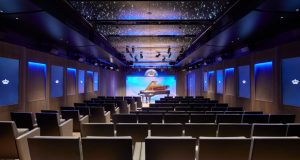 The IWFM London Region conference 2019, which took place in March, had one overriding message: The workplace is changing, and FM is leading the way. Sara Bean reports
The IWFM London Region conference 2019, which took place in March, had one overriding message: The workplace is changing, and FM is leading the way. Sara Bean reports
The conference might have taken place at Freemasons’ Hall, a historic art deco building in central London, but the focus was firmly on the 21st century and the idea of FM as a disruptor. The speakers explored topics ranging from the use of technology to streamline FM services to the shape of a ‘typical’ workplace in 20 years’ time.
Helping to set the scene, conference Chair Ian Ellison, Director and Co-Founder of 3edges, held up the first ever video phone, launched by Orange back in 1999. Its concept was sound, he explained, but the sticking point was that so few people owned a video phone there was no one to call. The device, however, was a harbinger of the modern iPhone, which has revolutionised the way we all work.
Said Ellison: “When I look at the agenda for today, it’s full of innovations and opportunities and reflects the fact that what FM needs to do is do what it does best.” The industry, he added, needed to invest in itself. “There has to be a desire to change, and a capability to change.”
Mike Gedye, Executive Director of Strategic Advisory Services at CBRE, and a recognised expert in emerging disruptive technologies, gave a talk wittily entitled ‘Dad, did you ever work at a desk?’ “Everyone will have noticed that work is increasingly becoming very agile, very flexible, very versatile, and very communal,” he said. “What it is not is static, predictable and generic.” FM must be “people and customer centric, by making an environment easy to use and a place that people want to be.”
FUTURE PROOFING
Referring to CBRE’s Portfolio 2040 research report, Gedye predicted that in the future the workforce will be largely self-employed and entrepreneurial and will demand space which is consumed as a service. Most significantly for FMs, he said: “We also predict that the workplace of the future will be viewed as a trophy, a reward for workers, and will include digital-free zones which can be seen as green spaces in the workplace where you can disconnect.”
Jeremy Campbell, Director of Business Development at Emcor Group, challenged the prevailing belief that it is the millennials who are driving change in the workplace. He argued that Gen X and the baby boomers have been disruptors for years, from the ready adoption of downloading films (spelling the demise of Blockbuster and the like) to the enthusiastic adoption of apps that offer on demand services.
In his presentation, which focused on how to take workplace data and use it to rethink FM, he argued: “Data will give FM the chance to examine how we deliver the customer experience. I love the idea that in the very near future we will be able to walk into buildings and the building will read us, know exactly who we are and understand our preferences [in term of lighting, heating and so on].”
The adoption of the word workplace into the IWFM moniker has sparked a debate on the role of FMs as workplace innovators, so it was interesting to hear from an FM with a chief workplace officer title. In her account of her elevation to CWO at educational publishing company Twinkl, Simone Fenton-Jarvis described her role as “the interface between people, place and process.” In practice, she explained, “this means looking after internal communications, leadership, culture, facilities, learning and development, CSR and lastly wellbeing.”
The rapid expansion of co-working and flexible workspaces is regarded as one of the greatest disruptors in the FM sector. According to Rob Strachan, Chief Marketing Officer of Landmark, “the flexible workplace has broadened its appeal beyond the SME who needs somewhere to go very quickly, to attracting larger organisations as part of an overall strategy.” Another disruptor is digital technology and the flood of data it has released, although not everyone regarded this as an unmixed blessing. Mike Gillespie, MD of Advent IM and a cyber-security expert, commented that “we’re now drowning in data and yet at the same time often starved of insight.”
THE GIG ECONOMY
A panel discussed whether the ‘Uberisation’ of FM will end up with staff joining the ranks of delivery drivers as members of the gig economy. Julian Kelly, Director of Business Development at Clean Event, was critical of the Uber service model. He believes that adopting it would be detrimental to what his sector is trying to achieve in terms of service and employee welfare, including driving up wages and improving conditions.
The challenge was taken up by former CEO of Servest, CJ Green, now founder of Tovip. “I believe that Uberisation and the move towards a gig economy is due to our workforces attempting to have more flexibility in their jobs, which is something many of their employers have really struggled to give. Unless we have done what we need to do to get ready for digital disruption, it will be here among us and we won’t be ready, which is why we need to get on with it now.”
Or, as Mike Gedye advised, we shouldn’t fear technology but embrace it to drive forward our businesses.
The conference concluded with Jeremy White, Executive Editor at Wired magazine, looking at a few of the developments we can expect in the near future. For example:
⇒ Virtual reality and FM. Imagine a world where you could wear a headset to ‘walk’ around your building to discover when a floor had last been cleaned, what assets needed repairing, or what plant was coming up for repair. All linked to the CAFM system.
⇒ Smart toilets, such as the Japanese-style ones that do everything for you. There may be a few glitches to iron out – there have been instances of them being hacked.
⇒ Visual AI in autonomous vehicles. These could deliver massive cost savings, as 25 per cent of the cost of goods is often the truck being used to deliver them.
⇒ Robotic canine security guards. A robotic dog already patrols Boston Dynamics’ HQ in place of human security guards.
⇒ Robotic chefs able to watch human chefs and copy them. A restaurant in Boston called Spice uses robots to serve 500 customers a day.
⇒ Bread bots that come to your office and make bread for you.




